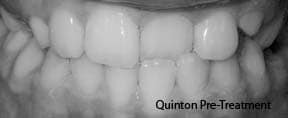
At Bluefish Dental & Orthodontics we are committed to providing personalized, focused care for each of our patients. We take the time to focus on individual needs and situations, and our treatment plans are custom designed. We work hard to find the most cost-effective and simple solution for every patient.
Case in point: Ten-year-old Quinton came to us with an underbite or crossbite of one tooth. One of his front teeth on top was trapped behind his front teeth on the bottom as it grew in. All of his teeth fit in the proper relationship except for this one tooth.
Quinton’s underbite, or anterior crossbite as it is known in dentistry, was isolated to a problem with the inclination or tip of one upper front tooth. This is different than someone who has an underbite because of a discrepancy in the position of jaws creating a “bulldog” like appearance. Quinton’s crossbite was a tooth problem, not a skeletal or jaw problem. As people vary, so do orthodontic problems. People can have combinations of tooth-only problems, jaw-only problems or combinations of both tooth and jaw problems contributing to the appearance of an underbite.
Options
In orthodontics, there are many appliances available to move teeth and or jaws to an extent. Conventional braces or brackets are one option which allows an orthodontist to hold on to a tooth and move it into a different location or orientation. Retainers with springs are another appliance option which can help to bump or nudge select teeth into a better position.
Quinton’s tooth was stuck or trapped behind his lower front teeth. Unfortunately, we cannot just bump the tooth out in front of the lower teeth because the tooth will run into the lower teeth on its movement forward. In order to move the tooth forward, it is necessary to slightly “prop” his bite open temporarily in order to remove the interference of the lower front teeth. This is usually accomplished with bonding tooth cement on the chewing part of the molars on the right and left, providing a small even bite plate that allows the teeth in front to not touch or overlap. The bite is only opened to the point that the trapped tooth in crossbite can move forward without interference.
In the past, we have commonly used braces to achieve a correction of this type of crossbite. The treatment with braces is simple; braces are placed on the upper front four teeth and the back molars. An expansion wire is placed to align the teeth and the bite is propped open with some temporary bonded cement on the molars to help remove any interference to the correction.
New Options
Throughout any given year, we attend numerous dental conferences ranging on the topics of pediatric dentistry, laser dentistry, orthodontics, and sleep obstruction/apnea in children. Not only does one benefit from the advanced education through the lectures, but also from the professional exchange with other practitioners and their clinical experiences. At a recent conference we had the pleasure of listening to several lectures on the diagnosis and treatment of various types of anterior crossbites. Alternative approaches to conventional braces in the treatment of anterior crossbites were presented for select cases.
One of the alternatives to placing braces in the case of a single tooth, dental only crossbite, was to open the bite temporarily and build up the tooth in crossbite (make it slightly bigger) so that it was functioning like a wedge with the lower teeth. The idea being that given its normal daily contact with the lower tooth, the upper tooth would have light and constant pressure to move forward, into a correct relationship with the lower tooth.
Once the upper tooth was in front of the lower tooth in a more correct orientation, the “wedge” or build up would be removed as the correction had been attained.
Quinton’s treatment:
Build ups were completed on both the chewing surface of Quinton’s molars to open the bite in the front of his mouth. A build up was completed on the front tooth in crossbite. The tooth was built slightly longer and slightly ahead of the edge of the lower front teeth by adding on white composite resin (the same material used for white fillings). No drilling or irreversible treatment was completed on any tooth. The treatment was a temporary add on.
Once the treatment was complete, both the build ups on Quinton’s molars and the composite resin on his front tooth was removed. The tooth will continue to settle in its new favorable position.
Case Findings:
Not all children benefit from the same treatment. There are many ways to achieve bite correction and tooth movement. That Quinton’s custom treatment worked well is a testimony to a good diagnosis, case selection (right treatment for the right problem) and a great patient.
Nice work Quinton!
